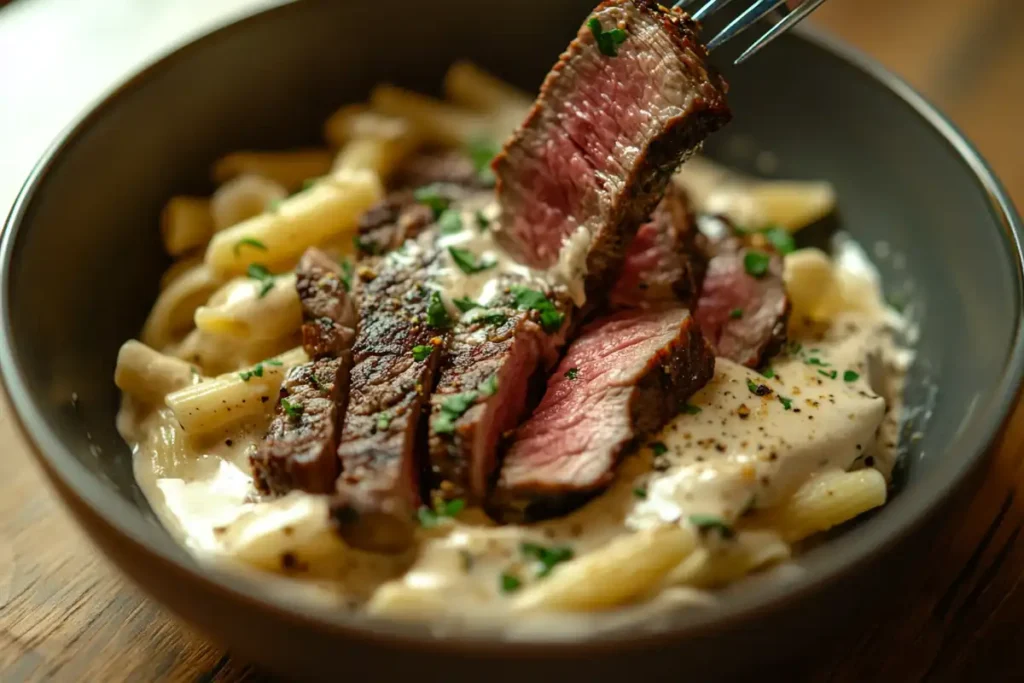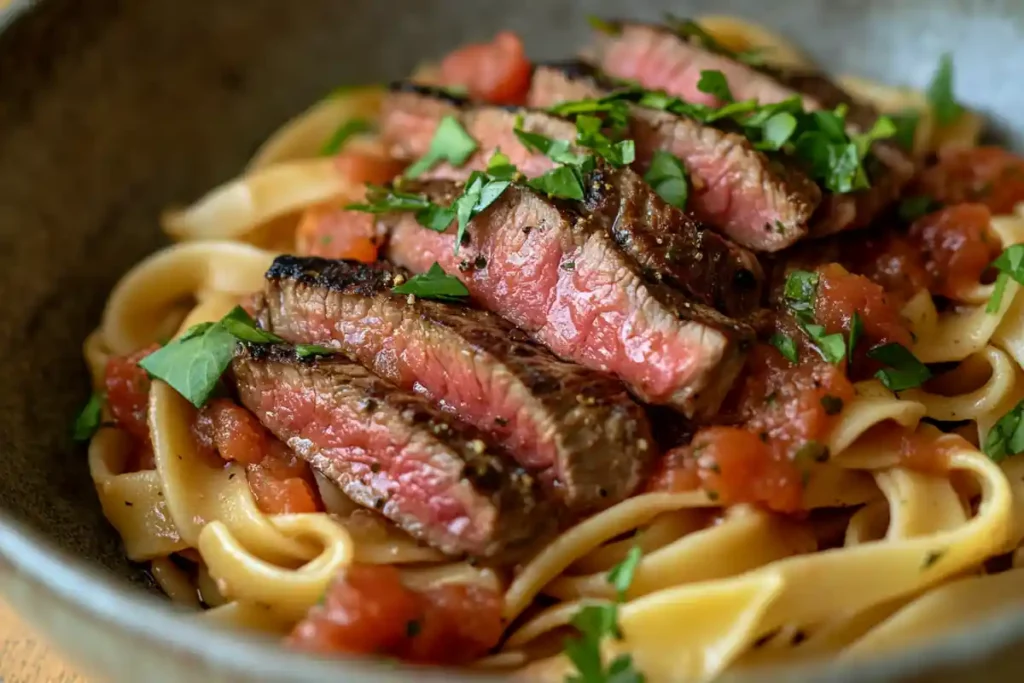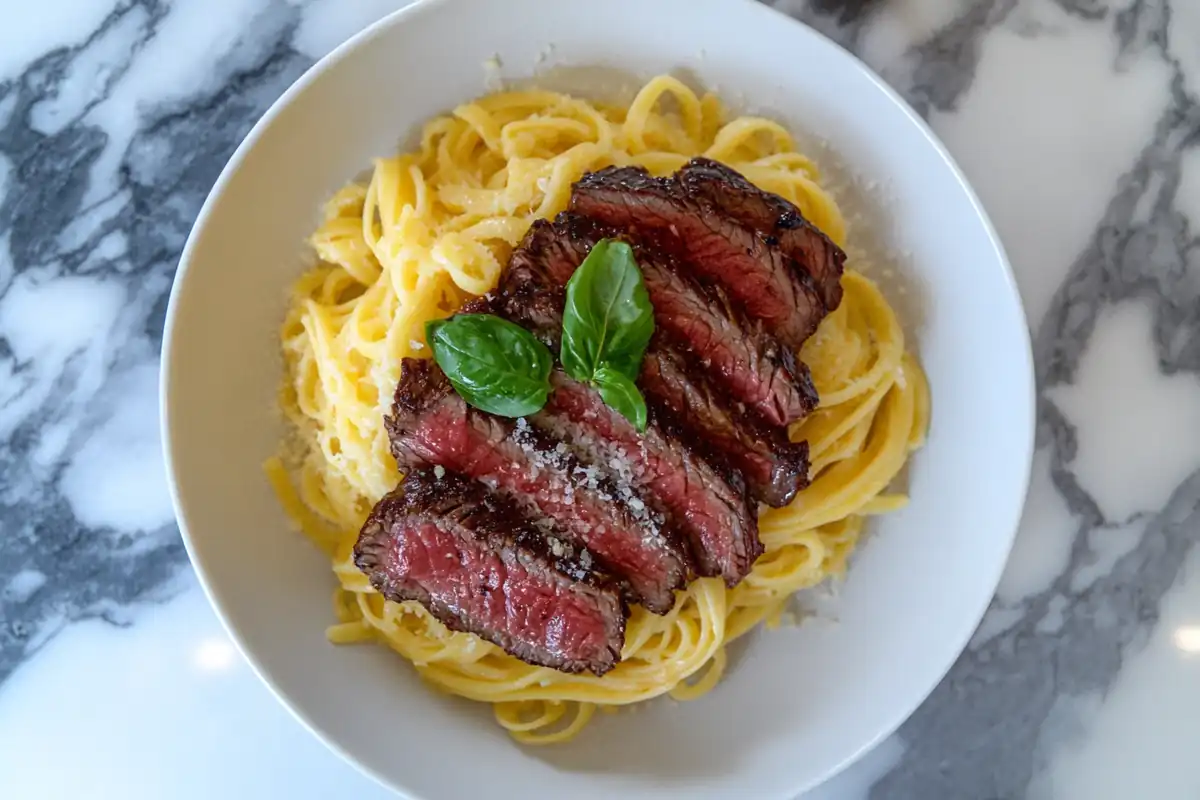What cut of steak is good for pasta? It’s a question that many home cooks ask when considering this satisfying meal. Combining steak and pasta can create a delicious and versatile dish, but the type of steak you choose will greatly affect the final result. This guide aims to demystify the process of selecting the right steak, providing you with the knowledge to make informed choices. We’ll explore different cuts and their unique qualities, so you can create a steak and pasta meal that perfectly matches your tastes.
Table of contents
- The Basics: Why Steak and Pasta Can be a Great Pairing
- Factors to Consider When Choosing Steak for Pasta
- Top Steak Cuts for Pasta
- How to Prepare Steak for Pasta
- Pairing Your Steak with the Right Pasta and Sauce
- Tips for a Great Steak Pasta Meal
- Common Mistakes When Combining Steak and Pasta
- Conclusion: Choosing the Best Steak for Pasta
- Frequently Asked Questions (FAQs)
The Basics: Why Steak and Pasta Can be a Great Pairing
Combining steak and pasta might seem simple. However, the way they compliment each other makes for a very interesting and satisfying meal. The richness of steak pairs very well with the mildness of pasta. Therefore, with the right sauce and ingredients, the combination is a great choice for both casual and sophisticated dining.
Why the Right Steak Cut Matters
While the idea of combining steak and pasta is good, the specific cut of steak you choose will make a big difference. Some cuts are more tender and flavorful, which is why they are better suited for this purpose than others. Choosing the right cut will help you to elevate your dish, making each bite as delicious as possible.
Factors to Consider When Choosing Steak for Pasta
Choosing the right steak for pasta is about finding the perfect balance of flavor and texture. Several factors should be considered before you make your final decision. Therefore, knowing these aspects will help you to make the best choice for your dish.
Tenderness
Tenderness is a very important factor for any kind of steak. Specifically, in a pasta dish, you want the steak to be tender and easy to eat. Tougher cuts might be harder to manage with pasta. Indeed, a tender steak will provide a better eating experience.
Flavor Profile
The flavor of the steak should also be carefully considered. While all steaks have flavor, some cuts offer a more intense flavor than others. A steak with a good rich flavor will compliment the pasta and sauce, making a more satisfying and complete meal.
Texture in a Pasta Dish
The texture of your steak should enhance, rather than detract from your pasta dish. You do not want a steak that is too chewy or too tough. The steak should be able to integrate well with the pasta and sauce, creating a harmonious meal where all of the textures work together.
Top Steak Cuts for Pasta

Sirloin adds tenderness and flavor to pasta.
Now, let’s explore some of the best steak cuts for pasta. Each cut has a distinct flavor and texture that might be more suitable for a pasta dish than others. Therefore, it is important to understand the unique qualities of each cut before making your choice.
Sirloin: A Versatile Choice
Sirloin is a very versatile and popular cut of steak. It’s a great option for pasta because it offers a good balance of tenderness and flavor. Sirloin is lean yet flavorful, and cooks quickly, making it a great choice when you do not want to spend too much time on the cooking process.
Ribeye: For a Rich Flavor
Ribeye is known for its intense flavor and rich marbling. The fat within this cut makes it exceptionally juicy and tender, which is great if you want to add a very indulgent element to your pasta. If you are aiming for a dish with a strong steak flavor, ribeye is a great choice.
Filet Mignon: For Unmatched Tenderness
Filet Mignon is one of the most tender cuts of steak. However, it has a milder flavor than other steaks. If you are aiming for a very soft texture and don’t want a very strong flavor, filet mignon is a great option. Its tenderness makes it very easy to eat, especially when combined with the pasta.
Flank Steak: A Lean and Flavorful Option
Flank steak is a leaner cut with a robust flavor. It’s best when sliced thinly across the grain, and cooked quickly, to keep it tender. This cut will provide flavor to your dish without adding a lot of fat. Therefore, it’s a great choice when you want a healthier option.
How to Prepare Steak for Pasta
The way you prepare the steak is just as important as the cut that you choose. The right cooking method can enhance the flavor and texture of the meat. Therefore, you need to know the best ways to get the best possible result.
Slicing Your Steak
When adding steak to pasta, it is essential to slice it properly. Slicing against the grain will help to make sure that the steak remains as tender as possible. Thin slices will also help to distribute the steak evenly throughout your dish.
Cooking Tips
Whether you pan-sear, grill, or bake your steak, the key is to cook it to your preferred level of doneness without overcooking it. Using a meat thermometer will help ensure the steak is cooked correctly. Allowing the steak to rest after cooking will help it retain its juices, making it tender and flavorful.
Importance of Not Overcooking
Overcooked steak will become dry and tough. This is the opposite of the tender and juicy result you’re looking for in a pasta dish. Therefore, monitor your steak very closely while you are cooking it, and remove it from the heat as soon as it reaches your desired level of doneness.
Pairing Your Steak with the Right Pasta and Sauce

A rich and satisfying pasta meal with ribeye steak.
Once you’ve chosen your steak, you need to think about the pasta and sauce that will best compliment it. The correct pairings can bring the meal together, making it more satisfying. Indeed, you need to give as much importance to the sauce and pasta as you give to the steak.
Pasta Types that Compliment Steak
- Long, flat pastas like pappardelle and fettuccine pair well with sliced steak.
- Tubular pastas like rigatoni and penne are great for chunkier pieces of steak.
- The right pasta will hold the sauce well and bring it all together.
Sauce Suggestions Based on the Steak Cut
- Creamy sauces pair well with tender, lean cuts like filet mignon.
- Tomato-based sauces are great with rich, flavorful cuts like ribeye.
- Garlic and oil based sauces are a good match with any steak cut. They highlight the natural flavor of the meat.
Tips for a Great Steak Pasta Meal
Here are a few extra tips that will help you create a truly great steak pasta dish, making the meal more memorable and enjoyable.
The Importance of Resting Steak
Let your steak rest for a few minutes after cooking. This allows the juices to redistribute within the meat, resulting in a more tender and flavorful piece of steak. Do not skip this step, as it is essential for a great result.
Finding the Right Balance
The best steak pasta dishes are those that have a great balance of ingredients, flavors, and textures. Make sure your steak is cooked well, the pasta is al dente, and the sauce compliments them both. Therefore, a well-balanced dish will always be more enjoyable.
Common Mistakes When Combining Steak and Pasta
Even when you know the best techniques, it’s easy to make a few mistakes when combining steak and pasta. Knowing these mistakes will allow you to avoid them and get a better result.
Overcooking the Steak
A common error when preparing this dish is overcooking the steak. This can make the steak tough and dry. Therefore, you should always watch the steak and take it out of the pan as soon as it reaches your preferred level of doneness.
Not Seasoning Correctly
Another common mistake is not seasoning the steak correctly. The steak must be well seasoned so that it is flavorful when you combine it with the other ingredients. Salt and pepper are essential, but you can also add other spices for a better taste.
Too Much or Too Little Sauce
Using too much or too little sauce is also a common problem when preparing a steak and pasta dish. You need to add just the right amount of sauce to compliment both the steak and the pasta, ensuring each element is enhanced and not overwhelmed. You do not want the sauce to overpower the other ingredients, nor do you want the dish to be dry and unappetizing. The key is to add the sauce gradually, tasting as you go, to find the perfect balance. Always remember that the sauce should enhance the other flavors rather than dominating them.
Conclusion: Choosing the Best Steak for Pasta
In conclusion, the best steak for pasta truly depends on your personal taste and what you are trying to achieve. However, tender and flavorful options, like sirloin, ribeye, filet mignon, or flank steak, are always great choices that will provide a good base to start from. By understanding the unique characteristics of each cut, and how each one can compliment the rest of your ingredients, you can create a steak pasta dish that is both delicious and satisfying. Ultimately, the creation of the perfect dish is about finding the perfect harmony of flavors and textures that suit your personal preferences, so don’t hesitate to try different combinations. So, experiment and find your favorite pairing.
Frequently Asked Questions (FAQs)
The best cut of steak for pasta depends on personal preference. However, versatile options such as sirloin, ribeye, and flank steak are always a great choice. They each have a different flavor and texture, allowing you to choose what’s best for you.
Many different meats pair well with pasta. These include beef, chicken, and sausage. However, when it comes to steak, some cuts are better than others. Those cuts with a good balance of flavor and texture will be a better choice.
Yes, steak goes very well with pasta. Indeed, it can create a very delicious and satisfying meal. The key is to choose the right cut of steak, the right pasta, and a complimentary sauce.
The best cut of steak when you are having a steak, is a matter of preference. However, some of the most popular cuts are ribeye, New York strip, and filet mignon. These are the classic options, and also have a great flavor.

